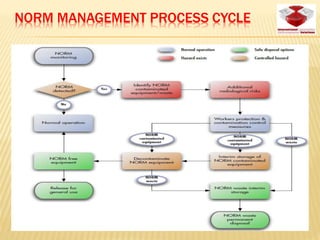Ad
Norm
- 1. NORM in Waste Derived From Oil and Gas Production Prof. Dr M.F. Abdel-Sabour E-mail:wise2007egy@yahoo.com ŌĆ½ž¦┘äž║ž¦ž▓ŌĆ¼ ŌĆ½┘łŌĆ¼ ŌĆ½ž¦┘äž©ž¬ž▒┘ł┘äŌĆ¼ ŌĆ½ž¦┘垬ž¦ž¼ŌĆ¼ ŌĆ½┘ģ┘åŌĆ¼ ŌĆ½ž¦┘ä┘垦ž¬ž¼ž®ŌĆ¼ ŌĆ½ž¦┘ä┘å┘łž▒┘ģŌĆ¼ ŌĆ½┘å┘üž¦┘Ŗž¦ž¬ŌĆ¼ ŌĆ½ž¦┘䞥ž©┘łž▒ŌĆ¼ ŌĆ½ž╣ž©ž»ŌĆ¼ ŌĆ½┘üž¬žŁ┘ēŌĆ¼ ŌĆ½┘ģ┘ģž»┘łžŁŌĆ¼ ŌĆ½žŻž»ŌĆ¼ ŌĆ½ž¦┘ä┘å┘ł┘ł┘Ŗž®ŌĆ¼ ŌĆ½ž¦┘äž©žŁ┘łž½ŌĆ¼ ŌĆ½┘ģž▒┘āž▓ŌĆ¼ Soil and water Research Department Nuclear Research Center Atomic Energy Authority
- 2. INTRODUCTION ’āÆ In the process of oil and gas extraction, the oil/gas/water mixture is brought to the surface through well tubing. The mixture then passes through a separator, which removes the gas. With further processing the gas is transported to a gas purification plant where the various gas fractions are separated and purified. ’āÆ The oil stream is further treated to remove the geological formation water that is extracted with the oil and gas. After separation from the oil, the formation water, also termed production water at this stage, is usually treated and discharged to the sea/ocean. ’āÆ Sand and oily sludge from the reservoir are also removed during this treatment. ’āÆ Solids deposit on the internal surfaces of the oil field extraction and production equipment, such as tubulars, other pipes, heat exchangers and pumps (Kvasnicka,1996).
- 3. INTRODUCTION Each year the petroleum industry generates several thousand tons of waste including produced water, scales, sludges, and contaminated equipment. The amount produced at any oil reserve varies and depends on several factors: ’āś Geological location ’āś Formation conditions ’āś Type of production operation ’āś Age of the production well.
- 4. INTRODUCTION ’āś NORM encountered in oil and gas exploration, development, and production operations originates in subsurface formations may contain radioactive materials such as uranium and thorium and their products, radium 226 and radium 228. These materials are brought to the surface in the formation water that is produced in the extraction of oil and gas (Cooper,2005). ’āśFormation water contains the radium isotopes 226Ra from the 238U series, and 228Ra and 224Ra from the 232Th series. All three radium isotopes; but not their parents; thus appear in the water co-produced with the oil or gas.
- 5. MAJOR FACTORS INFLUENCING THE OCCURRENCE OF NORM IN OIL/GAS PRODUCTION
- 6. Solid arrows indicate a radio active decay or series of radioactive decays. Dashed arrows indicate a physical or chemical partitioning process. Radon gas is highly mobile. It originates in underground formations and dissolves in the organic petroleum areas of the gas plant. It concentrates mainly in the more volatile propane and ethane fractions of the gas.
- 7. ’ā╝ NORM precipitate as sulphate and carbonate scales. ’ā╝ NORM generally occurs as radon gas in the natural gas stream. Radon decays to Lead-210, then to Bismuth-210, Polonium-210, and finally to stable Lead-206. ’ā╝ Radon decay elements occur as a film on the inner surface of inlet lines, treating units, pumps, and valves principally associated with propylene, ethane, and propane processing streams. Generally, the activity concentrations of radium isotopes are lower in sludge than in scales, the opposite applies to 210Pb (Zaidan,2010).
- 8. TYPE OF GENERATED WASTE Produced Waters ’āÆ The radioactivity levels in produced waters are generally low, but the volumes are large. ’āÆ The ratio of produced water to oil is approximately 10 barrels of produced water per barrel of oil. ’āÆ Produced waters contain levels of radium and its decay products that are concentrated. ’āÆ In general, produced waters are re-injected into deep wells or are discharged into non-potable coastal waters. According to the American Petroleum Institute (API, 1989), more than 18 billion barrels of waste fluids from oil and gas production are generated annually in the United States. Radium and its decay products may dissolve in the brine. They may remain in solution or settle out to form sludges, which accumulate in tanks and pits, or mineral scales.
- 9. TYPE OF GENERATED WASTE:- SCALE Scales are solid minerals that precipitate from produced water which has high salinity and contains sulfates and/or carbonates plus calcium, barium and strontium. The most common scales consist of barium sulfate (BaSO4), strontium sulfate (SrSO4) or calcium carbonate (CaCO3). Scale-forming material may also precipitate on sand and sludge particles and debris of scale may be mixed with sludge and sand inside vessels. Radium is chemically similar to these elements (Ba, Sr and Ca) and as a result is incorporated into the scales. Concentrations of Radium- 226 (Ra-226) are generally higher than those of Ra-228. While uranium and thorium are not soluble in water, their radioactive decay product, radium, and some of its decay products are somewhat soluble. Thus NORM scale contains practically no uranium and/or thorium. Under high temperature and pressure conditions in an oil reservoir, trace concentrations of barium, strontium, calcium and radium are leached out from reservoir sand and are present in a soluble form in the formation water. It has been estimated that: 25,000 tones of TE-NORM contaminated scale, and 225,000 tones of TE-NORM contaminated sludge, are generated each year by the petroleum industry.
- 10. TYPE OF GENERATED WASTE:- SCALE the largest volumes of scale occur in three areas: ’āś Water lines associated with separators, (separate gas from the oil and water) ’āś Heater treaters (divide the oil and water phases) ’āś Gas dehydrators, where scale deposits as thick as four inches may accumulate. Scale formation is caused by a combination of the following events (API,1989): 1. Mixing of incompatible waters; 2. pressure changes; 3. temperature changes; 4. impurities; 5. additives; 6. variation of flow rates; 7. changes in water acidity; 8. fluid expansion; 9. Gas evaporation; etc. Approximately 100 tons of scales per oil well are generated annually in the United States. Gas plant scales differ from oil production scales, typically consisting of radon decay products which accumulate on the interior surfaces of plant equipment. The average radium concentration in scale has been estimated to be 17.76 Bq/g (OSHA, 1989). It can be much higher (as high as 14800 Bq/g) or lower depending on regional geology.
- 11. TYPE OF GENERATED WASTE:- SLUDGE ’üČSludge generally consists of oily, loose material often containing silica compounds, but may also contain large amounts of barium. ’üČAPI (1987) has determined that most sludge settles out of the production stream and remains in the oil stock and water storage tanks. ’üČAs a result they pose a higher risk of exposure. The concentration of lead-210 is usually relatively low in hard scales, but may be more than 999 Bq/g in lead deposits and sludge. ’üČLike contaminated scale, sludge contains more Ra-226 than Ra-228. The average concentration of radium in sludges is estimated to be 2.775Bq/g. ’üČAlthough the concentration of radiation is lower in sludges than in scales, sludges are more soluble and therefore more readily released to the environment.
- 12. TYPE OF GENERATED WASTE:- SLUDGE ’üČThe results have shown that scales are 75% barium and strontium sulfates, with a mean (226)Ra and (228)Ra content of 106 kBq kg(-1) and 78 kBq kg(-1), respectively. ’üČThe (226)Ra and (228)Ra content in sludge also varies much more than the content observed in the scales samples and ranged from 0.36 to 367 kBq kg(-1) and 0.25 to 343 kBq kg(-1), respectively. Godoy and da-Cruz (2003
- 13. TYPE OF GENERATED WASTE:- CONTAMINATED EQUIPMENT Gas plant processing equipment is generally contaminated on the surface by 210Pb-. However, TENORM may also accumulate in gas plant equipment from radon (222Rn) gas decay. Equipment from gas treatment and transport facilities may also accumulate very thin films of 210-Pb formed by decay of short-lived radon daughters plated onto the inner surfaces. However, the total amount of waste is much less and the appearance of 210-Pb in gas production is not a waste problem to the same extent as radium sulphates in scales and sludges. .
- 14. NORM REGULATIONS ’üČThe Safety Guide on Occupational Radiation Protection [IAEA, (1999)] provides general guidance on the control of occupational exposures. This guidance is based on the requirements contained in the International Basic Safety Standards for Protection against Ionizing Radiation and for the Safety of Radiation Sources [IAEA series, (1996)]. ’üČThe objectives, concepts and principles of radioactive waste management are presented in the Safety Fundamentals publication on The Principles of Radioactive Waste Management [IAEA, (1995)].
- 15. HOW MUCH RADIATION IS IN THE WASTES? NORM in Egyptian oil field228Ra (Bq/kg)226Ra (Bq/kg)SampleField 1000-950,000ScaleAlgeria [32] 48,000-300.00021,000-250,000Australia [34] 4210-235.00019,100-323,000Brazil [35] 148,000-2.195.000121,000-3.500,000Brazil [36] 101,500-1.550.00077,900-2.110,000Brazil [37] 24,00068,900Egypt [27] 35,460-368.6547541-143,262Egypt [29] 32-50493-519Egypt [30] 200-10.000510-51,000Kazakhstan [39] 130,120-206.630114,300-187,750Malaysia [40] 300-33.500300-32,300Norway [41] 08-1.5Saudi Arabia [42] 30,00025,000SludgeAustralia [34] 49,000-52.00050,000-168,000Brazil [35] < LLD-117.900< LLD-413,000Brazil [36] 13,25018,000Egypt [29] 1-1.95.27-8.68Egypt [30] 45206-560Malaysia [40] 100-4600100-4700Norway [41] Environmental Radioactivity of TE-NORM Waste Produced from Petroleum Industry in Egypt: Review on Characterization and Treatment. M. F. Attallah, N. S. Awwad and H. F. Aly (1999), INTECH, October 31, 2012 ),
- 16. NORM MANAGEMENT PROCESS CYCLE
- 17. SCHEMATIC OF NORM SURVEY REQUIREMENTS
- 18. DISPOSAL AND REUSE: PAST PRACTICES ’āÆ Disposal of Wastes When sludge fouling in water and oil storage tanks became a problem, the tanks were drained and the sludge disposed of in waste pits: ’āÆ Burn pits Earthen pits were previously used for temporary storage a periodic burning of non- hazardous oil field wastes collected from tanks and other equipment. Lined and/or earthen pits were previously used for storing produced water and other nonhazardous oil field wastes, hydrocarbon storage brine, or mining wastes. In this case, TENORM in the water will concentrate in the bottom sludges or residual salts of the ponds. Thus, the pond sediments pose a potential radiological health risk. The radionuclides in these soils have been reported to be in the range from 9.99 to 40.7Bq/g. BRINE PITS
- 19. DISPOSAL AND REUSE: CURRENT PRACTICES ’āśOil recovery from oily waste (liquied/sludges) ’āśEnergy recovery from oily solid waste ’āśLoads of scrap metal are surveyed for hidden radioactive sources and TENORM. ’āśPiping and equipment are cleaned before release for recycling at smelters. ’āśPollution control devices, such as filters and bubblers, are installed in smelter stacks to reduce airborne radiation releases. ’āśAlthough much of the NORM- contaminated equipment is presently stored in controlled areas, some companies are now cleaning the equipment and proposing to store it at designated disposal sites.
- 21. DISPOSAL ALTERNATIVES ’āÆ (1) re-injection by hydraulic fracturing together with cuttings and other types of production waste ’āÆ (2) injection into the well bore during plugging and abandonment operations, ’āÆ (3) land depository by burial of waste with encapsulation or surrounded by a concrete barrier, and ’āÆ (4) depository in an abandoned mine, tunnel or other types of underground facilities. Sludges containing elevated TENORM are now dewatered and held in storage tanks for later disposal. Produced waters are now generally re-injected into deep wells or, in the case of offshore production facilities, are discharged into non-potable coastal waters. No added radiological risks appear to be associated with this disposal method as long as the radioactive material carried by the produced water is returned in the same or lower concentration to the formations from which it was derived. (Western Australia Chamber of Minerals and Energy, 1996) Contaminated equipment may be cleaned and reused by the petroleum industry or if radiation levels are sufficiently reduced, sold for recycle. If equipment cannot be further decontaminated to acceptable levels, it is sent to a landfill licensed to accept NORM materials.
- 22. DISPOSAL ALTERNATIVES Currently, in Australia, equipment with NORM scales is either cleaned for re-use within the industry or stored awaiting approval for scrap metal smelting, disposal or other recycling options. On some off-shore platforms, scale has been removed from pipes and tubulars and disposed of in a disused well which is then plugged; another option is to ground the scale to a fine powder, slurred with production water and discharged to the ocean. Pipes contaminated with scale are cleaned at pipe yards either by sandblasting them with high pressure water or by scraping out the scale with a rotating drill bit. The removed scale is then placed in drums and stored for later disposal. In some cases contaminated steel may be reprocessed via smelting. During the smelting process, molten steel separates from the NORM which vaporizes and is released as a gas. If the steel mill has pollution control equipment, most of the NORM is trapped in the bag-houses and scrubbers. A typical smelting operation is capable of capturing 99 % of the particulate releases Table 1. NORM waste disposal alternatives (Strand,1999).
- 24. ’āÆ PW is conventionally treated through different physical, chemical, and biological methods. In offshore platforms, because of space constraints, compact physical and chemical systems are used. However, major research efforts are being developed with innovative technologies for treating PW in order to comply with reuse and discharge limits. ’āÆ Among them, electrochemical technologies have been proposed as a promising alternative for the treatment of this kind of wastewaters (Dos Santos et al., 2014).
- 25. The waste generated in oil and gas equipment is due to the precipitation of alkaline earth metals as sulfate, carbonates and/or silicates. It is clear that sludge and scale wastes represent one of the major sources of 226-Ra in the environment.

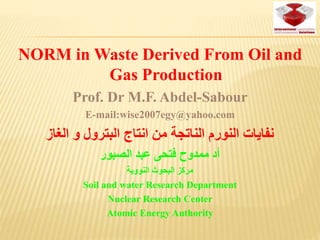







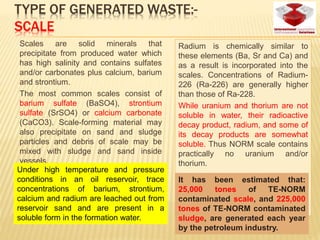
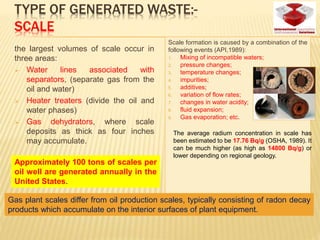
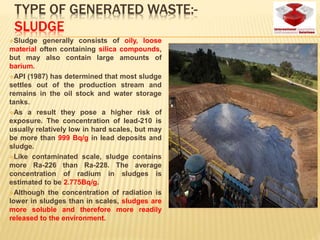


![NORM REGULATIONS
’üČThe Safety Guide on Occupational
Radiation Protection [IAEA, (1999)]
provides general guidance on the
control of occupational exposures.
This guidance is based on the
requirements contained in the
International Basic Safety
Standards for Protection against
Ionizing Radiation and for the
Safety of Radiation Sources [IAEA
series, (1996)].
’üČThe objectives, concepts and
principles of radioactive waste
management are presented in the
Safety Fundamentals publication on
The Principles of Radioactive Waste
Management [IAEA, (1995)].](https://image.slidesharecdn.com/6311f5dd-2566-426d-a258-cb535098acdf-160207134652/85/Norm-14-320.jpg)
![HOW MUCH RADIATION IS IN THE WASTES?
NORM in Egyptian oil field228Ra (Bq/kg)226Ra (Bq/kg)SampleField
1000-950,000ScaleAlgeria [32]
48,000-300.00021,000-250,000Australia [34]
4210-235.00019,100-323,000Brazil [35]
148,000-2.195.000121,000-3.500,000Brazil [36]
101,500-1.550.00077,900-2.110,000Brazil [37]
24,00068,900Egypt [27]
35,460-368.6547541-143,262Egypt [29]
32-50493-519Egypt [30]
200-10.000510-51,000Kazakhstan [39]
130,120-206.630114,300-187,750Malaysia [40]
300-33.500300-32,300Norway [41]
08-1.5Saudi Arabia [42]
30,00025,000SludgeAustralia [34]
49,000-52.00050,000-168,000Brazil [35]
< LLD-117.900< LLD-413,000Brazil [36]
13,25018,000Egypt [29]
1-1.95.27-8.68Egypt [30]
45206-560Malaysia [40]
100-4600100-4700Norway [41]
Environmental Radioactivity of TE-NORM Waste Produced from Petroleum Industry in Egypt: Review on Characterization and Treatment.
M. F. Attallah, N. S. Awwad and H. F. Aly (1999), INTECH, October 31, 2012 ),](https://image.slidesharecdn.com/6311f5dd-2566-426d-a258-cb535098acdf-160207134652/85/Norm-15-320.jpg)
